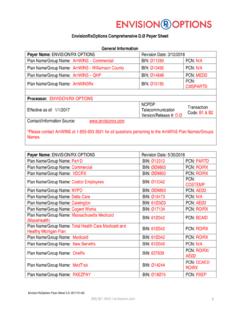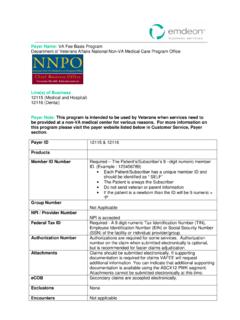Transcription of THE CASE FOR PAYER PARTICIPATION IN HEALTH …
1 THE CASE FOR PAYER PARTICIPATION IN HEALTH INFORMATION EXCHANGEAPRIL 2018 APRIL 20182 HEALTH information exchanges (HIEs) are collaborative efforts that focus on HEALTH data exchange on a community, regional, or statewide basis. They provide new and efficient ways for a wide and varied set of participants (providers, labs, hospitals, payers, public HEALTH agencies, pharmacies, patients/citizens, etc.) to receive and send data. The term HIE can be used as both a verb and a noun. As a verb, HIE refers to the act of exchanging data through whatever means and using whatever technology that is selected.
2 As a noun, HIE refers to the physical network or organization that enables the data exchange to take place (sometimes called Regional HEALTH Information Organizations, or RHIOs). HIEs are quite diverse; their services have yet to be fully leveraged by the PAYER community. TYPES OF HIEsThe HIE landscape continues to become more complex as different models of HIE have developed and, in some cases, are vying for their position in the interoperability marketplace (see Figure 1). State/ community HIEs are supported within a medical trading area, community, or state and can be the most challenging to sustain.
3 Some states particularly smaller ones have single, state-level HIEs, while other states, such as New York, pursue a model where they provide interconnection between regional HIEs. Still others merely facilitate HIE through selection of standards or deployment of lighter strategies, such as directed exchange. Most community HIEs continue to work on developing an appropriate business model and sustainability plan as the level of government funding experienced over the last several years is or organization HIEs are deployed and supported within a single organization or integrated delivery network (IDN) and may or may not interoperate beyond organizational boundaries.
4 Many IDNs have become complex organizations connecting hospitals, clinics, tertiary care centers, and small practices. The movement to accountable care organizations (ACOs) will further promote the development of these HIEs to serve the information exchange needs of medical homes and their supporting clinical third type of HIE, the electronic HEALTH records (EHR) vendor hub, has emerged as many EHR system vendors offer interoperability between installations of their products and often will provide less expensive external interfaces to/from these hubs.
5 For the EHR system vendor, participating in the other types of HIEs is a matter of strategic leverage. For providers, PARTICIPATION becomes a matter of lower cost and improved functionality. For communities, these vendor hubs may or may not make interoperability more efficient, as the hub is focused less on interconnecting a logical set of data trading partners as it does on the idiosyncrasies of who happens to be using a particular EHR 20183 For payers, PARTICIPATION in a state/community HIE is a more reliable way to ensure that interoperability can be enabled with as wide a variety of data trading partners as possible.
6 Private HIEs and vendor- dominated vendor hubs are restricted to the particular set of provider organizations or hospitals that are part of a corporate entity or who happen to be using a particular vendor s product. They do not promote wide-spread interoperability in a diverse healthcare ecosystem. State/community HIEs are governed by a more open, transparent, collaborative process where participants have a stronger say in the governance of the entity. State regulation may play a part in ensuring transparency and PARTICIPATION in national landscape is very mixed, however.
7 Consider: In Rhode Island, payers fund the state s HIE on a voluntary basis. However, current state law does not allow payers to access clinical data in the HIE directly even if patients opt in to participate. In Maine, where PARTICIPATION in the HIE is voluntary and their patient opt-out consent rule is considerably more permissive than New York s, Medicaid is the only major PAYER participating. In Utah, the HIE began as a claims clearinghouse and only subsequently began to work with clinical data. Payers have reasonably complete access to clinical data for their members in this opt-out state.
8 In other states, such as New York, the HIE contains clinical data that can be used quickly and easily to look up patient-specific information to support both pre-authorization for payment and, later, claims adjudication. In addition, Direct messaging provides secure e-mail between known correspondents that can contain protected HEALTH information (PHI).APRIL 20184 STATEWIDE HEALTH INFORMATION NETWORK FOR NEW YORK (SHIN-NY)Under the direction of the New York State Department of HEALTH (NYS DOH), the Statewide HEALTH Information Network for New York (SHIN-NY) was established to allow the electronic exchange of clinical information and connect healthcare professionals statewide.
9 The SHIN-NY is a network of networks comprised of New York s eight regional HEALTH information exchanges, or Qualified Entities (QEs). The QEs connect EHRs from participating healthcare professionals in each region, including those from hospitals, clinics, labs, radiologists, and ambulatory physicians, among others, and, with patient consent, allow those records to be shared securely with other participating healthcare professionals in their York State s Eight Qualified EntitiesAPRIL 20185 The SHIN-NY interconnects these regional networks to create a secure.
10 Statewide network designed to improve healthcare for all New Yorkers by ensuring that doctors have instant, accurate, and accessible information about their patients, anywhere and SHIN-NY supports the state s various value-based care initiatives moving healthcare towards a more fully integrated, patient-centric system. Today, the SHIN-NY connects 98% of hospitals in New York State, over 80,000 healthcare professionals, and represents millions of people who live in or receive care in New York network helps healthcare professionals across the state better manage patient care by providing access to clinical records, helping to reduce healthcare costs, improve care coordination, and increase the quality of care for patients in New York QEs offer basic services free of charge to participating organizations.





